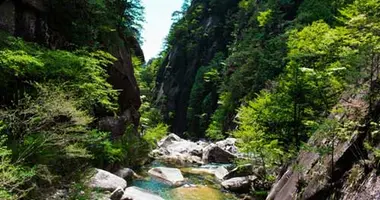Uguisudani, Tokyo's little-known railway station, between history and leisure
Located in Tokyo's Taito district, Uguisudani station is often regarded as a mere stopover between Ueno and Nippori stations. Yet this district is brimming with history and surprising activities. Let's discover the secrets of this valley of nightingales, from its artistic past to today's attractions.
Uguisudani, a small station with a big history
Uguisudani station was opened on July 11, 1912 to serve the Yamanote and Keihin-Tôhoku lines. Sandwiched between its big sisters, Ueno and Nippori stations, it is often seen as a mere transit station. Yet, with 25,375 daily passengers, it ranks 29th out of the 29 stations on the Yamanote circular line.
From the platforms at Uguisudani, railway photographers can admire the other lines that pass off-shore, such as the Tôhoku (Takasaki, Utsunomiya) and Jôban main lines. Special trains such as the luxurious TRAIN SUITE Shikishima can also be seen passing by.
The bucolic charm of yesteryear, a source of artistic inspiration
"Uguisu dani" literally means the valley of the nightingale (uguisu), a bird famous for its melodious song. Before Tokyo's galloping urbanization, this was a bucolic valley with a forest home to this enchanting bird. People came from far and wide to listen to it while enjoying fresh tofu.
From the end of the Edo period to the Meiji era, this corner of the countryside attracted artists in search of inspiration in the midst of a peaceful natural setting lulled by birdsong. Wealthy merchants also built magnificent second homes here. As a reminder of this past, the station's loudspeakers broadcast the song of the nightingale every morning.
Direct access to Ueno Park and its cultural treasures
The station's southern exit, built in 1927, leads directly into the famous Ueno Park, a mecca for hanami (cherry blossom viewing) every spring. This access is much faster and more convenient than from Ueno station, a crowded labyrinth of exits.
You'll reach the north of the park directly, ideal for visiting the prestigious Tokyo National Museum or Kan'eiji temple. The International Children's Literature Library and its building renovated by the famous architect Tadao Ando are also worth a visit, as is the famous Tokyo University of the Arts.
Traditional restaurants and century-old culinary institutions
The Uguisudani district is home to a number of historic restaurants. The best known is undoubtedly Sasanoyuki, a 350-year-old establishment specializing in traditional tofu. Opened in 1691, it has played host to such greats as poet Masaoka Shiki and writer Natsume Sôseki.
Sasanoyuki is open every day except Monday, from 11.30am to 10pm. If you love places steeped in history, don't miss this unique culinary and temporal journey!
In the footsteps of the great masters of literature and art
Uguisudani has attracted many artists and writers. You can visit the house of Masaoka Shiki, the great haiku master of the Meiji era, who lived here from 1894 until his death in 1902. Open from 10:30 a.m. to 12 p.m. and from 1 p.m. to 4 p.m., closed on Mondays.
The Calligraphy Museum, founded by Nakamura Fusetsu, an early 20th-century painter and calligrapher, displays his collection of Japanese and Chinese calligraphic works. Open from 9.30 a.m. to 4.30 p.m. except Mondays, it's another must-see for art and history lovers.
Love hotels", an unusual local specialty
The Uguisudani district is famous for its many "love hotels", hourly or nightly hotels for couples in search of intimacy. Several can be found near the north exit of the station.
First appearing in the 1960s, Japanese love hotels are often characterized by flashy architecture and fancifully decorated rooms. While their rates remain affordable (around 8,000 yen a night), some of the higher-end establishments offer services worthy of luxury hotels, with private Jacuzzis and saunas.
Not-to-be-missed museums and cultural sites
In addition to the places already mentioned, Uguisudani and the surrounding area are also home to a number of first-rate museums and cultural sites:
- Tokyo National Museum, the country's largest and oldest museum, with 110,000 works of Japanese and Asian art. Allow around 2 hours for your visit.
- The National Museum of Nature and Science, with an impressive evolution gallery tracing the history of life and a state-of-the-art planetarium.
- The Ueno Metropolitan Art Museum, with its high-quality temporary exhibitions showcasing the Japanese art scene.
- The Tokyo Cultural Center, a vast complex housing theaters, bookstores, restaurants and the Idemitsu Art Museum with its collection of Japanese paintings and Asian antiques.
Uguisudani is a veritable concentration of Tokyo's history, art and culture. In fact, this discreet station conceals countless treasures that will delight curious travellers. So, are you ready to get off the beaten track and explore this fascinating valley of nightingales?













































